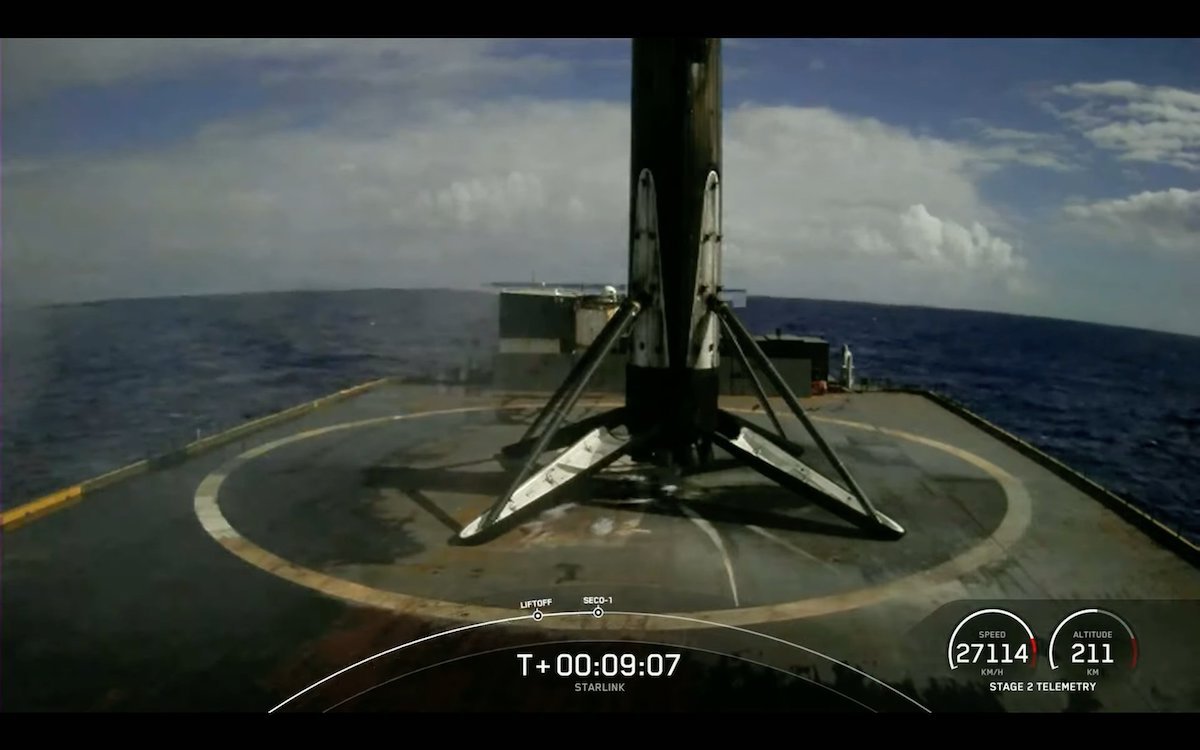
Another batch of 47 internet satellites launched Thursday on a Falcon 9 rocket from Kennedy Space Center, heading into the sky to join SpaceX’s Starlink broadband network on the company’s ninth mission in nine weeks, keeping pace with a goal of around 50 Falcon flights this year.
Under a clear sky with calm winds, the Falcon 9 rocket lit its nine Merlin 1D main engines and climbed away from pad 39A at Kennedy Space Center at 9:25 a.m. EST (1425 GMT) Thursday.
Heading southeast, the engines generated more than 20 million horsepower to propel the Falcon 9 rocket through most of the Earth’s atmosphere in two-and-a-half minutes, before shutting down falling away to reveal the rocket’s second stage engine to take over the mission.
The first stage, flying on its 11th mission, used control thrusters to re-orient itself at the edge of space, then extended four titanium grid fins for stability during descent back to Earth. Braking burns by the rocket’s main engines guided the booster toward SpaceX’s drone ship “Just Read the Instructions” parked downrange in the Atlantic Ocean near the Bahamas.
SpaceX confirmed the rocket — designated B1060 in SpaceX’s inventory — landed on the platform nearly nine minutes after liftoff, just as the second stage engine switched off after placing its satellite payloads into a parking orbit.
A second burn by the upper stage engine delivered the 47 satellites to a near circular orbit at an altitude of almost 200 miles (320 kilometers). The flat-packed, quarter-ton satellites released from the rocket all at once just shy of the 66-minute mark in the mission.
The Starlink deployment completed the 118th consecutive successful mission by SpaceX’s Falcon rocket family since September 2016, when a Falcon 9 exploded on the launch pad and destroyed the Israeli Amos 6 communications satellite.
Elon Musk, SpaceX’s founder CEO, said last month that the company plans around 50 launches this year. SpaceX launched Falcon 9 rockets on 31 missions in 2021, a record number for a U.S. company in a calendar year. The Falcon boosters successfully landed on all but one flight last year.
“I have launch PTSD every time a rocket takes off,” he said. “I’m like, agh! I just see all the ways that it could fail. This year we’re actually aiming to have around 50 launches, so it’s about a launch per week on average. So it’s a hell of a year we’ve got ahead of us.”
Launches for the Starlink network will take the largest share of SpaceX’s missions this year, but there are numerous commercial and military missions on the schedule. There are approximately 30 missions for external customers on SpaceX’s schedule that could launch before the end of 2022.
Up to five Falcon Heavy missions could launch this year for the U.S. Space Force, NASA, and Viasat.

Once free of the rocket Thursday, the 47 new Starlink spacecraft — built by SpaceX in Redmond, Washington — were expected to extend their solar panels and turn on ion engines to begin climbing to an operational altitude of 335 miles (540 kilometers). They will also activate their communications payloads, including antennas, transmitters, receivers, and laser cross-links to pass data between the satellites in orbit.
With the fresh satellites deployed Thursday, SpaceX has launched 2,234 Starlink spacecraft to date, including prototypes and older models no longer in service. Jonathan McDowell, an astrophysicist who regularly tracks spaceflight activity, estimated SpaceX had 1,945 functioning Starlink satellites in orbit, as of Wednesday.
SpaceX doesn’t release information on the health and status of its Starlink satellites.
The launch Thursday occurred just six days after SpaceX’s previous Starlink mission from California. SpaceX plans another Starlink launch on a Falcon 9 rocket March 8 from Cape Canaveral Space Force Station, putting the company closer to reaching a goal of deploying roughly 4,400 Starlink satellites to beam high-speed, low-latency internet services around the world.
Eventually, SpaceX has signaled in regulatory filings it wants to operate as many as 42,000 internet satellites, all flying in low Earth orbit a few hundred miles above the planet.
The number of satellites planned by SpaceX and other companies have raised questions about the safety of operations in low Earth orbit, including how the fleets might create more space debris and cause problems in managing the ever-growing number of objects circling the planet.
Astronomers have also criticized the Starlink program for ruining some telescope observations, but SpaceX has mitigated the problem by making their satellites less reflective of sunlight.
But the upside of space-based internet services was on display in recent days after SpaceX shipped Starlink antennas to Ukraine to help citizens remain connected amid Russia’s military attack, which began Feb. 24.
Two days later, Mykhailo Fedorov, Ukraine’s vice prime minister, asked Elon Musk for help on Twitter.
“While you try to colonize Mars — Russia try to occupy Ukraine!” Fedorov tweeted in a public message to Musk. “While your rockets successfully land from space — Russian rockets attack Ukrainian civil people! We ask you to provide Ukraine with Starlink stations and to address sane Russians to stand.”
Musk responded the same day that Starlink service was activated in Ukraine. A shipment of Starlink user terminals arrived in Ukraine Monday, according to Fedorov.
“Starlink keeps our cities connected and emergency services saving lives!” Fedorov tweeted Wednesday, adding that Ukraine needs electrical generators to keep Starlink and other “life-saving services” online after Russian attacks on local infrastructure.
Email the author.
Follow Stephen Clark on Twitter: @StephenClark1.
